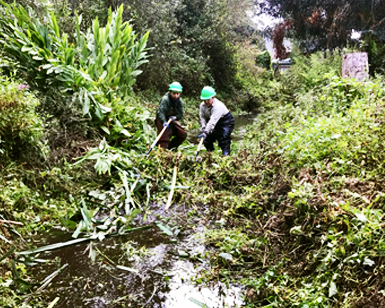San Rafael, CA – The intense 2016/17 winter season was one of Marin County’s wettest in more than a decade, causing $8.76 million in damages to County-maintained infrastructure in unincorporated areas. The damage would have been exponentially worse without the annual storm preparation projects spearheaded by Marin County Department of Public Works (DPW).
 Cleaning out debris from creedbeds during the summer and fall is just one method used to help reduce winter flooding.
Cleaning out debris from creedbeds during the summer and fall is just one method used to help reduce winter flooding.
Conducted every summer and fall, the methodical work on countywide precautions is crucial for flood mitigation and stormwater drainage. While there’s no way to know what this winter holds for Marin, DPW has been busy for months preparing for a potentially serious rain season.
“Often when a storm is brewing, we get asked by the media whether their people can come watch our workers clearing creeks of debris,” said Tony Williams, DPW Principal Civil Engineer. “Our response is usually, ‘We would be happy to but we already did it months ago.’ We stay on top of it and we hope that’s comforting to a lot of people.”
Storm season preparations cover a wide range of work including creeks, levees, pump stations and tide gates. Tasked with this responsibility, the Marin County Flood Control and Water Conservation District identifies and implements projects in eight designated flood control zones across Marin. The zones do not cover the entire county and are, for the most part, concentrated in the county’s eastern urbanized corridor. In total, the District oversees 38.71 miles of creeks and 8.18 miles of levees.
Each summer, the District inspects 43 pumps housed at 17 stations across Marin’s watersheds to ensure that they are functioning at optimal efficiency. The pumps play an essential part in flood reduction for neighborhoods such as Tiburon’s Strawberry Circle and Bel Aire, lower Tam Valley, and for key roadways such as Highway 101 offramps at Rowland Boulevard in Novato. The District coordinates with DPW’s Building Maintenance and Fleet Operations Divisions to complete annual service requirements on all pump stations, including wet wells, electric motors and natural gas engines. The District also performs major maintenance for each pump on a six-year cycle, which includes full extraction and cleaning of the machinery. Over the summer, nine of the 43 pumps received their six-year major maintenance protocol.
Pump stations transport stormwater from low-lying lands into creeks, facilitating natural water flow out to San Francisco Bay. To maximize that flow, creek maintenance is a major part of summertime storm preparations. The District works with local agencies, such as Conservation Corps North Bay and municipal public works departments, to handle maintenance on 18 creeks across the eight watershed zones. Teams perform extensive vegetation management including mowing of overgrowth and removal of dead foliage from creek banks. Excess sediment, dead trees and man-made debris are removed to maximize creek flow capacity.
The projects range greatly in size, but a significant undertaking this season was the joint drainage project for Rush Creek, just north of downtown Novato. Flooding at that location can impact the downtown area and businesses along Redwood Boulevard. The project was collaboration between California Department of Transportation (Caltrans), City of Novato and the District.
After the 2016/17 storms, approximately a quarter-mile of Novato Creek’s 5.41 miles of levees required fundamental repairs, particularly near the Vintage Oaks shopping center in Novato. The District and DPW road crews fixed the damaged levee sections and reinforced weak points. Standard maintenance was conducted on 2.77 miles of levees in the areas of Richardson Bay, Santa Venetia, and Ross Valley. The standard protocol includes inspection for levee weak points, fortifying with supportive material and filling rodent burrows to prevent leaks during the wet season.
Roadway work, handled by DPW’s Roads Division, is an important part of storm season preparedness. Improving roadway drainage systems was a major facet of this summer’s series of pavement projects, but annual practices also require inspecting and cleaning roadside storm drains using a process called vactoring. Conducted in early fall, the process removes debris buildup and reduces the chances of clogging during storms. Compared with other areas of Marin, Tam Valley and Santa Venetia require significantly more extensive vactoring because of their low elevation and propensity for flooding.
There are hundreds of roadside drainage ditches along arterial and rural roads in unincorporated Marin, and those require attention as well. Sir Francis Drake Boulevard, Point Reyes-Petaluma Road, Novato Boulevard, Lucas Valley Road, Paradise Drive and Panoramic Highway were among those getting seasonal service. Upkeep on the ditches helps control stormwater flow and minimize roadside erosion. Hundreds of culverts, inlets and flow pipes are also inspected and, if needed, cleared along all County-maintained roads.
During the fall months, roads crews also handle street sweeping to keep debris out of drains and creeks. They utilize two large street-sweeper trucks and run routes across areas of unincorporated Marin with the densest concentration of trees along neighborhoods streets: Loma Verde, Marinwood, Greenbrae, Kentfield and Tam Valley.
Residents are encouraged to also take action prior to rainy season to help mitigate flooding of private property. Clearing dead leaves from rooftop gutters and storm drains are simple and effective ways to avoid flooding. Dead foliage should be disposed in compost bins, not left in street gutters to clog drainage systems. If you live in an area of historic flooding, preemptively stocking of some sandbags (available at most hardware stores) and learning how to properly use them can be a huge help if the stormwater starts rising.
To learn more about storm preparations, visit DPW’s creeks, bay and flood information page or Marin Watersheds website.